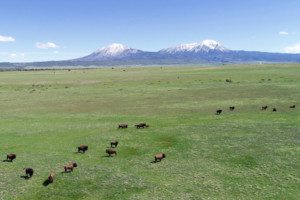In order to have a successful ranch income property, you’re going to need to create a ranch management plan. It doesn’t matter if you’re sharing hunting tags, providing fishing excursions, or ranching cattle, you’ll need a comprehensive plan to keep organized. Let’s dive into creating a ranch management plan for your business.
What is a Ranch Management Plan?
If you’re planning on making money from your ranchland, you’ll want a comprehensive ranch management plan to keep you organized. In many ways, a ranch management plan is similar to a business and marketing plan.
However, this document dives a little deeper. You’ll not only want to include a marketing plan and business plan within your ranch management plan, but you’ll also want to include managing the raw resources of your ranch property.

When to Create Your Ranch Management Plan
Before buying a ranch, you’ll want to consider the foundations of your ranch management plan. While you’re going through the buying process, you’ll notice that different properties have different assets. This means you can’t possibly plan everything before you buy a ranch.
However, you’ll want to buy a ranch that suits the overall mission of your ranch income property. So start developing your ranch management plan before you begin to look, and fill in the details as you go along. At the very least, your prospective ranch property should uphold the most important part of your ranch management plan, the mission statement.
Steps for Creating a Successful Ranch Management Plan
Creating a ranch management plan isn’t as straight forward as it may seem. This living document is subject to change. You’ll often find yourself thinking about the various elements during different parts of the buying and moving process.
A well-knowledged ranch land broker (such as ourselves), should aid you in the planning process, especially if you’re a first-time buyer. Here’s what to include in your ranch management plan. Just don’t be shy about revisiting different parts of the plan as your ranch develops.
1. Decide the Overall Intent of Your Ranch Property
Before you sign the contract, you’ll want to decide what you want your dream ranch property to be. Do you want to use it for commercial cattle? Perhaps you’d like to sell a portion of your given hunting tags. Or maybe you’d prefer to run fishing tours on that perfect stretch of river that runs through your fishing ranch.
Either way, create a mission statement. This statement should answer the questions: What does your ranch do and what purpose does it serve? The answer should be more honed in than “make money.” Get creative and use an umbrella that best fits your vision.
2. A Ranch Management Plan with a Purpose
Every plan needs goals, otherwise what’s the point? Think about the objectives and goals of your ranch. You can use a specific monetary goal, sales goal, or efficiency goals. Monetary goals are always worth having, but efficiency or spending goals can be excellent tools too, especially if you’re adding improvements. Your goals should be (SMART):
- Specific
- Measurable
- Attainable
- Rewarding
- Have a timeline
3. Think About Proper Pasture and Resource Management
Think about how you will manage the land as a whole. This includes plans for maintaining forests, water resources, pasture, fencing, soil, etc. If you’re new to this idea, you’ll want to do a little research on your specific location. Understand items such as:
- Your land’s water rights and waterways
- The specific soils and best practicing for farming the land.
- Grass and pasture makeup. How much water is needed? How long does it take for pasture to recover?
- Fire mitigation
- Forest clearing and resource harvesting to promote healthy wildlife populations

4. How Will You Manage Animals and Equipment?
Next up, you’ll want to know how many animals you plan on supporting. This will drive how much land you need. Think about how your stocking rate will change and what number of livestock you plan to start with. Remember, different animals need different amounts of space, resources, water, and food.
Next up, what equipment will you use? Do you need to purchase equipment (we’ll get there in a second). How are you going to maintain, upkeep, and store the equipment?
5. Decide on Personnel Management
Who’s going to manage everything? You and your family? That’s a great idea if it’s the only thing you plan to do. However, typically you’ll need some hired help. Think about both your homestead and your greater ranch. For example, you may want landscapers, but you may also want ranch hands to help maintain the cattle herds.
Each of these things has a cost, so don’t forget to factor in things like wages, benefits, PTO, and other items. Think of these folks as your staff. You’ll want to aid in career development, rewards or incentives, goal setting, and the like. The key to a successful ranch is a team that loves to work together towards both individual and common goals.
6. Create a Start-Up Expenses and Investments List
Often times, one of the biggest cost setbacks of any ranch is your start-up expenses. Don’t forget to include start-up costs and any equipment investments. You’ll also want to set aside a section of your ranch management plan to account for the annual costs of running your income-producing ranch.
7. What’s Your Marketing Plan?
Now that you’ve got your head around your goals, costs, and improvements, you’ll need a way to market your services. For cattle, there are several different ways to do this via a flexible stocking rate and timing sales with favorable market conditions.
However, for other services, such as lodging, fishing, and hunting, you will need to figure out how you will attract customers. If you’re not well-versed in this area, it may be helpful to jot some ideas down and speak with a marketing consultant to get you squared away.

8. Create a Bookkeeping Plan
Record keeping is essential for a successful ranch management plan. You need a system that easily keeps track and monitors critical information. Choose a tool that lets you track things like the health of your herd or property, maintenance, financial statements, as well as operational reports. These items make it easy to analyze the success of your ranching efforts.
Now you’ve got the tools you need to create a successful ranch management plan. Keep in mind that this is just a starting point. As you go along, you may discover your original intent isn’t the best practice for your ranch. Don’t be afraid to re-evaluate your plan and tweak your document. Each year review your plan against reality and see if any changes need to be made.


